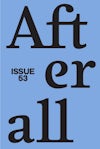
Issue 8
Autumn/Winter 2003
Editors: Charles Esche, Thomas Lawson, Mark Lewis, Silke Otto-Knapp, Zoe Crosher.
Founding editors: Charles Esche, Mark Lewis.
Table of contents
Foreword
Contextual Essays
- Empire as Cinema – Andreas Spiegl
- Notes on the Subject Without Qualities: From the Cowboy Flaneur to Mr Smith – Walead Beshty
Artists
James Benning
- Reeling in Utah: The Travel Log Trilogy – Dick Hebdige
- James Benning’s California Trilogy: A Lesson in Natural History – Rachel Moore
Dominique Gonzalez-Foerster
- Modern Future Past Park: On a Plan for Escape by Dominique Gonzalez-Foerster – Jan Verwoert
- The Multi-Faceted Cinema of Dominique Gonzalez-Foerster – Alexis Vaillant
Rosemarie Trockel
- Ich war eine Glocke – Hans-Christian Dany
- Mechanics of Meaning, or the Painting Machine – Anne Wagner
- To Think Is to Pause – Lilian Haberer
Surasi Kusolwong
- Work, Action, Production: Three Parallel Voices on the Art of Surasi Kusolwong – Charles Esche
- Numbers! Colours! Surasi Kusolwong’s Alternative Economy – Doryun Chong & Doryun Chong
Sharon Lockhart
- A Fine Disregard – Rosetta Brooks
- The Possible’s Slow Fuse: The Works of Sharon Lockhart – Chus Martinez
Foreword
Written by Thomas Lawson
Garnett’s 1930s studio film Her Man stars now-forgotten Hollywood-actress Helen Twelvetrees, who plays a tragic young woman trapped in a cycle of forced prostitution and petty thievery…
Her Man (Tay Garnett, 1935)
Garnett’s 1930s studio film Her Man stars now-forgotten Hollywood-actress Helen Twelvetrees, who plays a tragic young woman trapped in a cycle of forced prostitution and petty thievery. Working her trade in a fictional Caribbean port, she falls in love with one of her prospective marks played by Phillips Holmes. Towards the end of the film she is walking in the street and collides with a cyclist. For a moment her shoe gets stuck in the wheel of the bike and, as she frees herself, the shoe is catapulted across the street into the gutter where it disappears into a nearby sewer. To the immense and cruel entertainment of the collected passers-by, she walks away from the accident, hobbling on one high-heel shoe until she passes Phillips Holmes who, having secretly watched the whole episode, gathers her up forcefully in his arms and bundles her into a passing horse-drawn taxi. It is a slapstick moment; difficult to describe, it has to be seen. And it is just one of a series of visual gags and comedic moments that makes this highly formulaic and stage-bound film memorable in ways that are almost inexplicable.
Up until the moment of the shoe gag, the love story between Helen Twelvetrees and Phillips Holmes has not really begun. It has, from time to time, been the subject of some flirtation and banter between the two of them, and indeed other characters in the film react with humour, suspicion and even hostility…
Purchase
The publication is available for purchase. If you would like specific articles only, it is also available individually and to be downloaded as PDFs.
Purchase full publication
Buy via University of Chicago Press
Buy via Central Books
Purchase individual articles
Buy via University of Chicago Press



